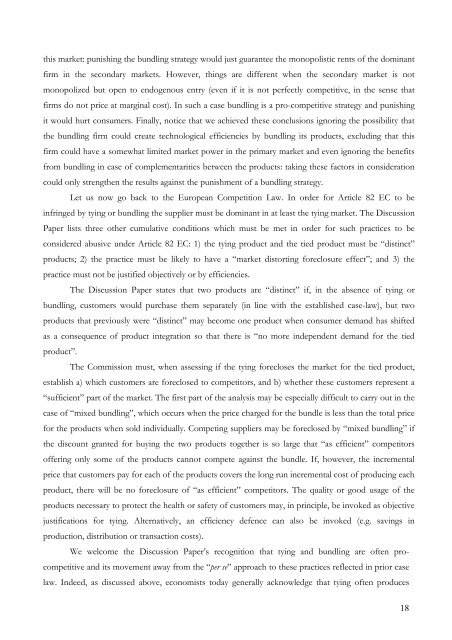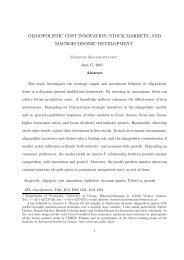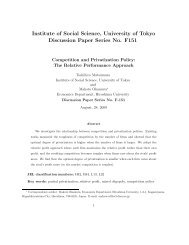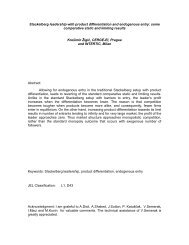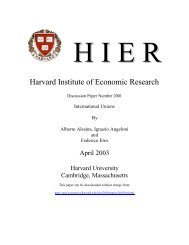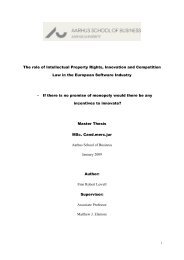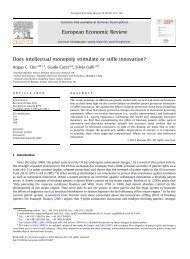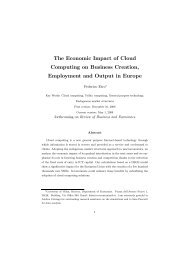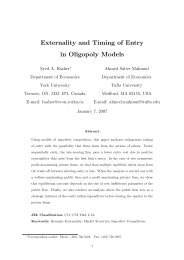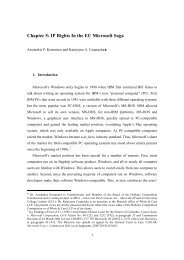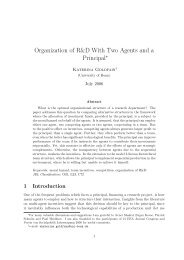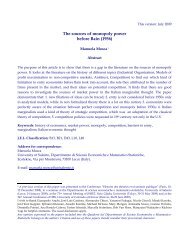The EU Approach to Abuse of Dominance - Intertic
The EU Approach to Abuse of Dominance - Intertic
The EU Approach to Abuse of Dominance - Intertic
Create successful ePaper yourself
Turn your PDF publications into a flip-book with our unique Google optimized e-Paper software.
this market: punishing the bundling strategy would just guarantee the monopolistic rents <strong>of</strong> the dominant<br />
firm in the secondary markets. However, things are different when the secondary market is not<br />
monopolized but open <strong>to</strong> endogenous entry (even if it is not perfectly competitive, in the sense that<br />
firms do not price at marginal cost). In such a case bundling is a pro-competitive strategy and punishing<br />
it would hurt consumers. Finally, notice that we achieved these conclusions ignoring the possibility that<br />
the bundling firm could create technological efficiencies by bundling its products, excluding that this<br />
firm could have a somewhat limited market power in the primary market and even ignoring the benefits<br />
from bundling in case <strong>of</strong> complementarities between the products: taking these fac<strong>to</strong>rs in consideration<br />
could only strengthen the results against the punishment <strong>of</strong> a bundling strategy.<br />
Let us now go back <strong>to</strong> the European Competition Law. In order for Article 82 EC <strong>to</strong> be<br />
infringed by tying or bundling the supplier must be dominant in at least the tying market. <strong>The</strong> Discussion<br />
Paper lists three other cumulative conditions which must be met in order for such practices <strong>to</strong> be<br />
considered abusive under Article 82 EC: 1) the tying product and the tied product must be “distinct”<br />
products; 2) the practice must be likely <strong>to</strong> have a “market dis<strong>to</strong>rting foreclosure effect”; and 3) the<br />
practice must not be justified objectively or by efficiencies.<br />
<strong>The</strong> Discussion Paper states that two products are “distinct” if, in the absence <strong>of</strong> tying or<br />
bundling, cus<strong>to</strong>mers would purchase them separately (in line with the established case-law), but two<br />
products that previously were “distinct” may become one product when consumer demand has shifted<br />
as a consequence <strong>of</strong> product integration so that there is “no more independent demand for the tied<br />
product”.<br />
<strong>The</strong> Commission must, when assessing if the tying forecloses the market for the tied product,<br />
establish a) which cus<strong>to</strong>mers are foreclosed <strong>to</strong> competi<strong>to</strong>rs, and b) whether these cus<strong>to</strong>mers represent a<br />
“sufficient” part <strong>of</strong> the market. <strong>The</strong> first part <strong>of</strong> the analysis may be especially difficult <strong>to</strong> carry out in the<br />
case <strong>of</strong> “mixed bundling”, which occurs when the price charged for the bundle is less than the <strong>to</strong>tal price<br />
for the products when sold individually. Competing suppliers may be foreclosed by “mixed bundling” if<br />
the discount granted for buying the two products <strong>to</strong>gether is so large that “as efficient” competi<strong>to</strong>rs<br />
<strong>of</strong>fering only some <strong>of</strong> the products cannot compete against the bundle. If, however, the incremental<br />
price that cus<strong>to</strong>mers pay for each <strong>of</strong> the products covers the long run incremental cost <strong>of</strong> producing each<br />
product, there will be no foreclosure <strong>of</strong> “as efficient” competi<strong>to</strong>rs. <strong>The</strong> quality or good usage <strong>of</strong> the<br />
products necessary <strong>to</strong> protect the health or safety <strong>of</strong> cus<strong>to</strong>mers may, in principle, be invoked as objective<br />
justifications for tying. Alternatively, an efficiency defence can also be invoked (e.g. savings in<br />
production, distribution or transaction costs).<br />
We welcome the Discussion Paper’s recognition that tying and bundling are <strong>of</strong>ten procompetitive<br />
and its movement away from the “per se” approach <strong>to</strong> these practices reflected in prior case<br />
law. Indeed, as discussed above, economists <strong>to</strong>day generally acknowledge that tying <strong>of</strong>ten produces<br />
18


